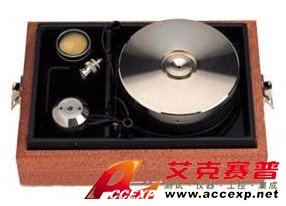關(guān)于我們






湖南省長(zhǎng)沙市開福區(qū)車站北路湘域智慧南塔

0731-84284278

0731-84284278

service@hncsw.net



0731-84284278





B&K 4290 校準(zhǔn)激振器

名稱:過(guò)程校準(zhǔn)儀

品牌:

型號(hào):

簡(jiǎn)介:4290 校準(zhǔn)激振器 Calibration Exciter Type 4290 is an electrodynamic vibration exciter designed to vibrate accelerometers or sm...
申請(qǐng)服務(wù)
- 產(chǎn)品介紹
4290 校準(zhǔn)激振器

Calibration Exciter Type 4290 is an electrodynamic vibration exciter designed to vibrate accelerometers or small components at variable frequency in the range 200 Hz to 50 kHz. This range, with reliable acceleration control up to 30 kHz, makes the Calibration Exciter a useful reference device in high frequency vibration work.
The Exciter consists of two separate parts, a cylindrical permanent magnet and a small compact moving element with built-in control accelerometer. When the moving element is placed onto the core of the permanent magnet, the drive coil is situated in the radial magnetic field produced by the magnet. Suitable suspension is obtained by simply inserting a disc of foam nylon between the moving element and the magnet core. (This type of floating suspension has no transverse resonance in the frequency range of the calibration exciter.)
The suspension resonance occurs at 30 to 100 Hz. Small dimensions, extreme compactness and rigid construction, give the moving element an outstandingly high first resonant frequency: above 50 kHz. The built-in control accelerometer, which has a mounted resonant frequency around 60 to 70 kHz, follows exactly the movement of the table, and the output signal is used to control and monitor the acceleration at the table surface.
The exciter will be driven by a sine/noise generator through a power amplifier. The maximum force output which is around 3 N (0.675 lbf) peak is obtained with a power of 2.5 W.
The acceleration level obtained with a typical 30 g accelerometer is of the order 1 ms–2 (0.1 g) which is sufficient for calibration of piezoelectric accelerometers.
The calibration exciter can be used in environmental test chambers in a range from 0 to 80˚C (32 to 176˚F).
Example of Use
The main purpose of the calibration exciter is the automatic plotting of the high frequency response of accelerometers in combination with a Brüel & Kjær Type 3550 Analyzer (with WT 8091 software) and a printer. A measuring set-up is shown in Fig. 1. The drive signal is provided by the generator module in the analyzer which covers the frequency range 200 Hz to 50 kHz, and the Power Amplifier Type 2712 (or 2706).
The built-in control accelerometer monitors the vibration level and...

Calibration Exciter Type 4290 is an electrodynamic vibration exciter designed to vibrate accelerometers or small components at variable frequency in the range 200 Hz to 50 kHz. This range, with reliable acceleration control up to 30 kHz, makes the Calibration Exciter a useful reference device in high frequency vibration work.
The Exciter consists of two separate parts, a cylindrical permanent magnet and a small compact moving element with built-in control accelerometer. When the moving element is placed onto the core of the permanent magnet, the drive coil is situated in the radial magnetic field produced by the magnet. Suitable suspension is obtained by simply inserting a disc of foam nylon between the moving element and the magnet core. (This type of floating suspension has no transverse resonance in the frequency range of the calibration exciter.)
The suspension resonance occurs at 30 to 100 Hz. Small dimensions, extreme compactness and rigid construction, give the moving element an outstandingly high first resonant frequency: above 50 kHz. The built-in control accelerometer, which has a mounted resonant frequency around 60 to 70 kHz, follows exactly the movement of the table, and the output signal is used to control and monitor the acceleration at the table surface.
The exciter will be driven by a sine/noise generator through a power amplifier. The maximum force output which is around 3 N (0.675 lbf) peak is obtained with a power of 2.5 W.
The acceleration level obtained with a typical 30 g accelerometer is of the order 1 ms–2 (0.1 g) which is sufficient for calibration of piezoelectric accelerometers.
The calibration exciter can be used in environmental test chambers in a range from 0 to 80˚C (32 to 176˚F).
Example of Use
The main purpose of the calibration exciter is the automatic plotting of the high frequency response of accelerometers in combination with a Brüel & Kjær Type 3550 Analyzer (with WT 8091 software) and a printer. A measuring set-up is shown in Fig. 1. The drive signal is provided by the generator module in the analyzer which covers the frequency range 200 Hz to 50 kHz, and the Power Amplifier Type 2712 (or 2706).
The built-in control accelerometer monitors the vibration level and...
最新產(chǎn)品
























